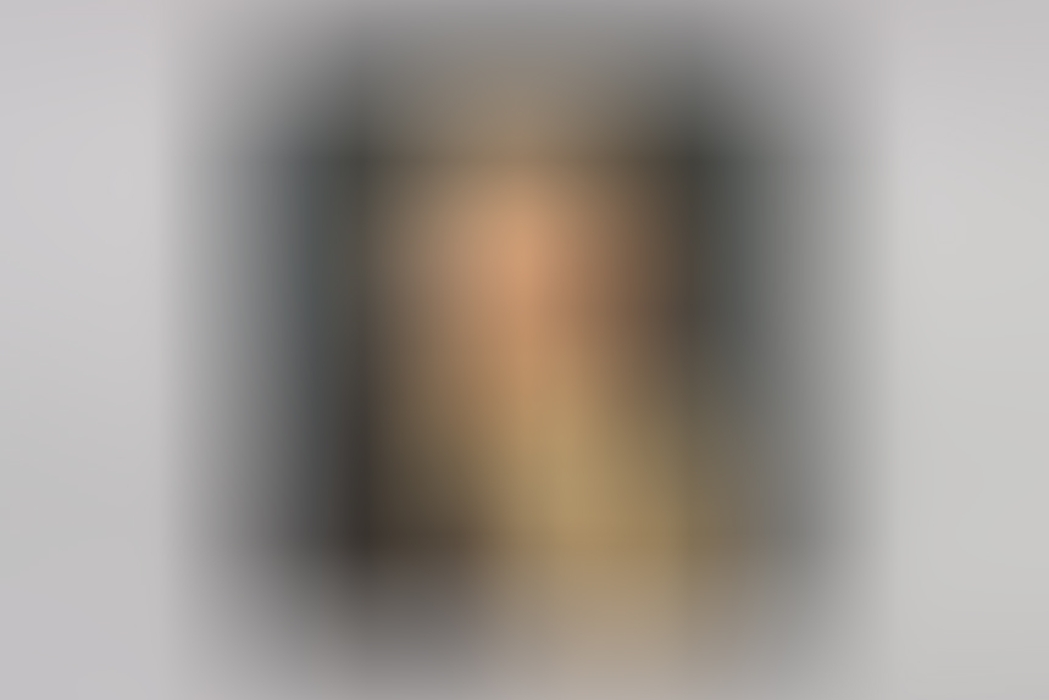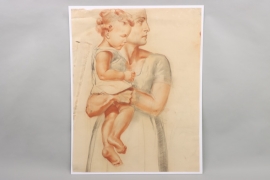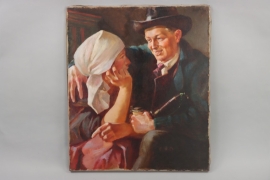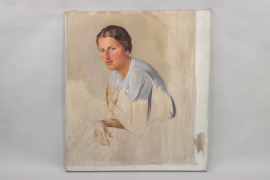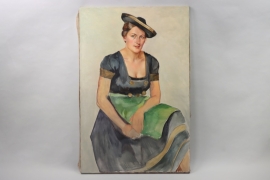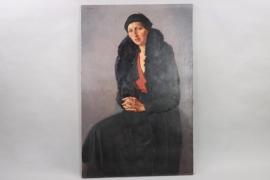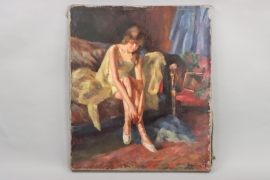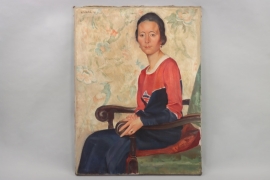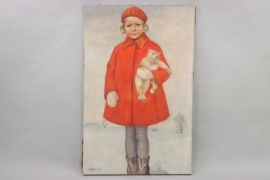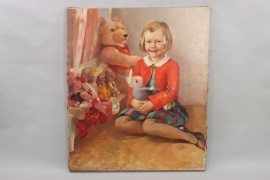46th Contemporary History Auction
Bidding on 1830 lots has ended on 6th March 2022. 92% of all lots sold
Diebitsch, Karl - his daughter Helga (oil on wood)
MILITARIA PRICE GUIDE
How can I see results?
We continue to publish our last three auction catalogues containing results, descriptions and pictures free of charge for all customers once logged in!
Earlier catalogues are now accessible for subscribers of the new ratisbon's MILITARIA PRICE GUIDE only. This new feature not only provides full access to all past catalogues but supplies sold items in a categorized price guide. Visit www.ratisbons.com/militaria-price-guide for more details.
Own a similar product you want to sell? We are here for you at +49 8541 9053699
-
PAYMENT
-
HOW CAN I PAY FOR MY ORDER?
AUCTIONSYou will receive an e-mail confirming your successful bids the day after the auction has ended. In your personal my ratisbon's you will be able to inform us about your most convenient payment method for this order or tell us about an alternative shipping address.
If we don’t hear from you within 24 hours, we will send an invoice choosing the payment and shipping options which we think are the most comfortable ones to you. If you decide to change your shipping or payment method after receiving your invoice, just drop us a line or visit my ratisbon's/ORDERS for any more details.
SHOP ORDERSChoose your payment method when ordering and submit your order. Once your order has been received we will send an invoice including your shipping costs and your payment instructions.
After receiving the invoice, the order must be paid within 7 days.
Please contact us to discuss layaway options.To learn more about paying at ratisbon's, please see your FAQ pages.
WE ACCEPT FOLLOWING PAYMENT METHODS
-
-
Versand
-
HOW DO YOU SHIP MY NEW TREASURES?
PACKING & TRACKINGWe usually send out orders within 1-3 working days after your payment has been received. In most cases, we are faster than this! We will inform you when your goods are being dispatched and provide a tracking number, In addition, you can always check your order status at my ratisbon's/ORDERS. Delivery times will vary depending upon the delivery destination and type of shipping service you have chosen.
SHIPPING TO ALTERNATIVE ADDRESSIf you prefer to have your order shipped to your work address or a friend during your absence, we will happy to arrange this for you. Send us an email letting us know about your new shipping address and we will be happy to send an updated invoice to you.
OUR LOGISTIC PARTNERS ARE AS FOLLOWS
-
-
OUR GUARANTEE
-
 OUR GUARANTEE!
OUR GUARANTEE!We only offer collectables which to the best of our specialists knowledge are authentic. About 15% of all consignments are returned to the consignor after extensive research due to authenticity issues.
Unlike traditional auction houses we do offer a full right of return. If you are not satisfied with what you won or bought, you may return it within 14 days. Please inform us and we will instruct you on how to return the goods. For more information, please visit FAQ pages.
Important note: Cancelling bids after an auction may disappoint the consignor, who like you is a collector. This situation is easy to avoid. We encourage you not to bid on any collectable if you are unsure if it fits into your collection. Ask us to cancel your bid 24 hours prior to the end of an auction to avoid this situation.
-
COUNTRY Germany 1918 - 1945
DIMENSIONS 46cm x 42 cm
WEIGHT
EAN 2000000629131
PERIOD 1918 — 1945
COUNTRY Germany 1918 - 1945
MATERIAL
DIMENSIONS 46cm x 42 cm
MAKER
WEIGHT
COUNTRY Germany 1918 - 1945
LOT 57-0915
DIMENSIONS 46cm x 42 cm
EAN 2000000629131
MAKER
WEIGHT
Description
Karl Diebitsch (January 3, 1899 Hannover - August 6, 1985 in Kreuth)
Diebitsch attended school in Hanover and then began an apprenticeship as a decorative painter. Due to the First World War, he suspended his training and volunteered in October 1915 as a war volunteer (navy). He received the Iron Cross, second class, for his service and was promoted to gunner in 1918. After the war, he completed the apprenticeship in decorative painting with the journeyman's examination. In the winter semester of 1919/20 he studied at the Art Academy in Munich, where he attended the drawing school with Hermann Groeber.
In addition to his artistic training, Diebitsch also began to get involved politically when he moved to Munich. As early as 1919 he was in the armored train of the residents' militia in Munich. He met Dietrich Eckart and a little later Adolf Hitler and joined the NSDAP in May 1920 (member number 1463). In the spring of 1920 he took part in the Ruhr battles. In 1921, as a member of the Freikorps Oberland, he took part in battles on the German-Polish border and was seriously wounded in the battles at Annaberg. In Breslau he was one of the founding members of the local NSDAP group. In 1923 he undertook sabotage actions in the occupied Rhineland. Diebitsch viewed the development of the party after it was banned and re-established critically, which is why he resigned and initially did not apply for membership again (this did not happen until 1937 (membership no. 4690956)).
From 1923 to 1925 he attended the Munich Academy again, where he was again a student of the then influential Hermann Groeber. In addition to Diebitsch, important students of Groeber included Thomas Baumgartner, Hermann Otto Hoyer, Ginger Paulsen and Hans Stadlberger. After completing his education at the Academy at the latest, Diebitsch worked as a portrait and genre painter in Munich. The results were remarkable portraits of high quality. The Impressionist-influenced style of his teacher can sometimes be seen in his early works, while he found his own distinctly realistic style at the end of the 1920s.
On April 23, 1925 he married Anna, née Raithel. The marriage produced a son and daughter, Helga.
As late as the 1920s, Diebitsch turned to painting porcelain, but also painted glass and faience. From 1927 to 1931 he was manager of a porcelain painting company in Munich. Due to the economic conditions at the time, demand fell and he was initially unable to find a permanent job.
In 1933 he applied to join the SS, which was granted on September 9, 1934 (SS No. 141990). On the day he joined, Heinrich Himmler promoted him to SS Obersturmfuhrer. For Himmler, as head of the "Department for Cultural Research" within the personal staff of the RF-SS, Diebitsch became a central adviser on artistic questions. Together with Walter Heck, Diebitsch designed the SS uniforms. On January 1, 1936 he became SS Hauptsturmfuhrer, on November 9, 1936 SS Sturmbannfuhrer and on July 25, 1937 SS Obersturmbannfuhrer.
On January 3, 1936, Diebitsch founded the Allach Porcelain Manufactory (PMA) together with SS members Franz Nagy, Theodor Kärner and Bruno Galke.
In the years that followed, Diebitsch received numerous public contracts. Among other things, he designed the scabbard for the SS dagger M36, arranged for the design of SS barracks, created the designs for various postage stamps and designed costumes. His most famous work is certainly the Yule candlestick - the main product of the PMA.
On the occasion of Joachim von Ribbentrop's appointment as SS Obergruppenfuhrer in 1940, Heinrich Himmler gave him the monumental painting "Defense of the Leibstandarte - SS" by Karl Diebitsch.
On January 4, 1937, Diebitsch went to the baptismal ceremony of the then one-year-old Thorisman Wolff, son of Karl Wolff, Heinrich Himmler's chief adjutant. The ceremony was designed by Karl Maria Weisthor, along with Himmler and Heydrich, one of the godparents.
In 1939 Diebitsch was best man at the marriage of Jochen Peiper, whom he had known since 1935, and his wife Sigurd Hinrichsen, one of Himmler's secretaries. Diebitsch remained close friends with the Peipers.
On April 20, 1939, Adolf Hitler awarded him the title of professor at Himmler's request.
From January 15 to July 28, 1940, Diebitsch was commander of the Totenkopf-Standard 11, and then briefly commander of the SS Panzergrenadier Regiment 10 "Westland" and later commander of the SS Flak Abt. "Vikings".
On April 20, 1944, he was awarded the Iron Cross, First Class.
After the Second World War, Karl Diebitsch worked for the Heinrich & Co. porcelain factory in Selb, among other things. At that time, together with Karl Mötsch, he developed the so-called Heinrich Gemmo porcelain, a special method of processing porcelain in which the motif to be painted is concavely ground into the porcelain by hand. In 1955-56 he worked briefly for the newly founded Niederrhein porcelain factory and shortly thereafter (1957) he worked for Lorenz Hutschenreuther in Selb. In 1959 his book “Figuren. Porcelain sculpture then and now” was published (Bamberg). In the last years of his life, Diebitsch returned to painting. He died as a widower on August 6, 1985 in his apartment in Kreuth.
TITLE: „Helga“ [so marked at the bottom left, Bust of the at the time 9 year old daughter Helga]
MATERIAL: Oil paint on wood, unframed
DATE: dated at the bottom right „[19]36“
SIZE: 46 x 42 cm
SIGNATURE: signed bottom right „C. Diebitsch“
CONDITION: Somewhat rubbed down in the edge areas, as well as isolated smaller losses of the paint layer; corners slightly scuffed; Plate slightly stained on the verso, as well as with several small holes (woodworm no longer active)
In front of a completely dark background, Karl Diebitsch shows a bust of his daughter Helga. Her body can be seen here in profile to the left, while her head turns towards the viewer. The delicate, quite serious-looking face is framed by two long blond pigtails. And it is - but not only - the form of the pigtails, which inevitably draws comparisons with the later well-known portrait of Diebitsch’s daughter from 1939, which was shown in 1940 at the "Great German Art Exhibition" and then again put on display in 1944 at "Deutsche Künstler und die SS" (Breslau and Salzburg). In the catalog for "Deutsche Künstler und die SS" the painting "Helga" is mentioned with praise where it says: "Professor Carl Diebitsch kept alive the wishful thinking of all fathers in the field - the memory of wife and child - through the child portrait of his daughter Helga."
While Helga in that painting, who was twelve at the time, looks to the left edge of the picture, not noticing the viewer and thus making a very grown-up impression, Diebitsch captures her in this bust from a few years earlier in an extremely finely and harmoniously painted portrait, displaying a more paternal and personal experience.
Artistically, a wonderful testimony to the realistic portrait art of the 1930s, which due to the identification of the sitter as the daughter of the artist undoubtedly becomes a special rarity.
Condition
2-

